What Year Was The First Camera Made
The intriguing history of ghost photography
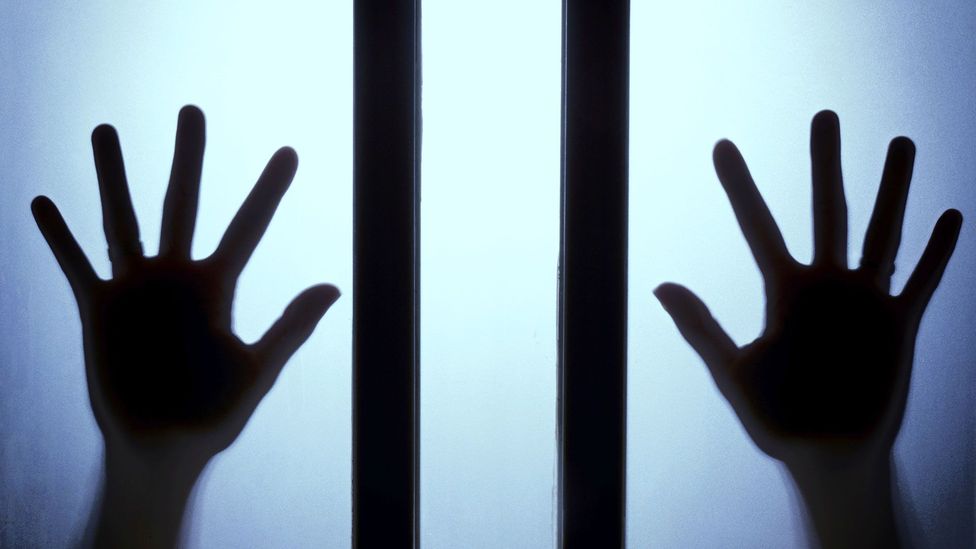
As camera tech has evolved, then too has the photography of puzzling 'spirits', and as Howard Timberlake discovers, they even appear in smartphone shots.
I
It'due south February 2015 at Hampton Court Palace in London. Twelve-year-sometime Holly Hampsheir grabs her iPhone to have a photo of her cousin, Brook, as she walks alone through the majestic Male monarch's Apartments. Snap.
It'due south not until the following day that they find Brook was not lone in the motion-picture show. A alpine, grey, seemingly cloaked woman follows behind her. In a second photograph, this strange anomaly is gone.
Was it a stunning image of a tortured bogeyman making a rare operation for the cameras, or something more... well... sensible?
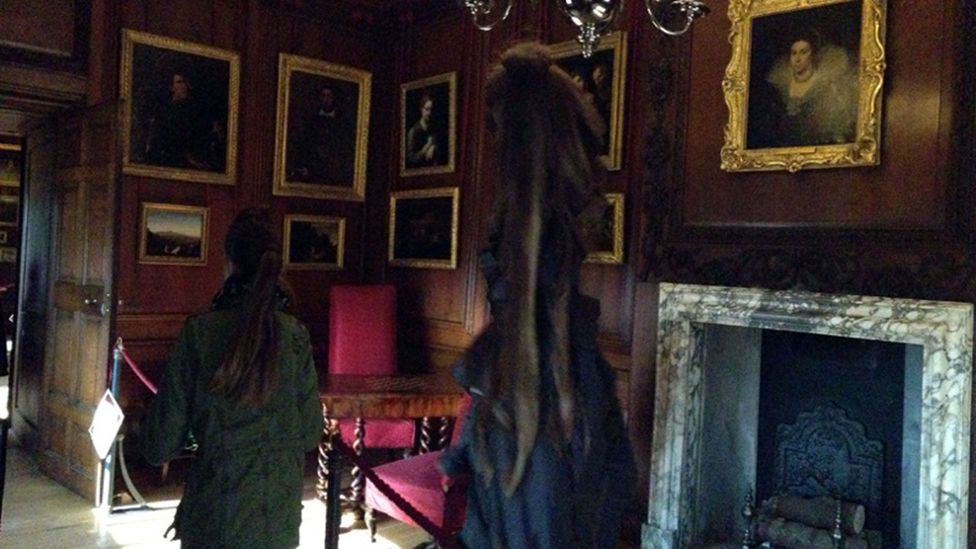
'Ghost photos' withal occur today - like this 'sighting' of the Grey Lady of Hampton Court; actually an oddity from an iPhone'southward imaging capture (Credit: The Sun/News Syndication)
The reply, as we'll find, says more nearly how smartphones take photos than anything supernatural. In fact, this grayness ghoul is simply the latest bogeyman in a fascinating history of ghost photography. Ever since the camera was invented, spooks have appeared in photos. And with each advance in camera technology, new types of ghostly traces take emerged – or been deliberately conjured.
"I am a sceptic from the perspective of a photographer and as someone who doesn't believe in ghosts… in that location'southward not a lot out there that can't be attributed to some sort of photographic technique," says Michael Pritchard, director-general of the Royal Photographic Society.
Sixth sense and sensibility
The roots of spirit photography can be traced dorsum to the 19th Century. During the 1850s and '60s, many photographers were experimenting with new furnishings such as stereoscopic images and double exposure. Merely some unscrupulous photographers soon realised that these techniques could exist exploited for profit.
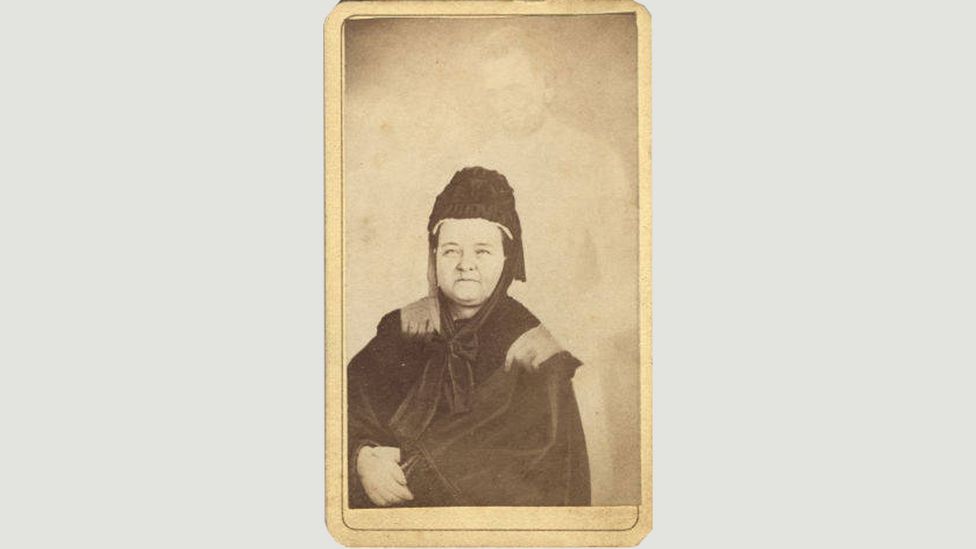
Mumler was accused of fraud for photographs such as this, with former US President Abraham Lincoln (Credit: Lincoln Fiscal Foundation Drove, Allen Land Public Library)
An enterprising American amateur photographer chosen William Mumler is thought to be the first person to capture a 'spirit' in a photograph in the early 1860s.
This momentous image appeared to feature the bogeyman of his dead cousin. Ghostly visitation or not, it wasn't long before Mumler's knack of capturing expressionless people on moving picture (normally a relative) had become very pop. At the offset, experts struggled to find anything fake about Mumler's spirit photographs. And then the amateur became a professional person – with a lucrative business fuelled by the relatives of those killed in the American Ceremonious War – great to make some kind of supernatural connexion with their loved ones.
Mumler may take achieved this past inserting a previously prepared positive glass plate, featuring the image of the deceased, into his camera in front of an unused sensitive glass plate, which was and so used to photograph his client. This double exposure technique not only captured the paradigm of the client merely likewise the ghostly image from the prepared glass plate in front end.
In one of Mumler's more famous efforts, the 'ghost' of Abraham Lincoln photobombs an image of his wife, Mary Todd Lincoln. The list of his clients grew, but so did his critics.
I detail sceptic of Mumler's work was the showman PT Barnum, who claimed that the spirit photos were only preying upon families or individuals overcast by grief. This followed allegations that Mumler had cleaved into houses to steal photos of deceased relatives, and that some of the 'spirits' featured in his photos were actually even so very much alive.
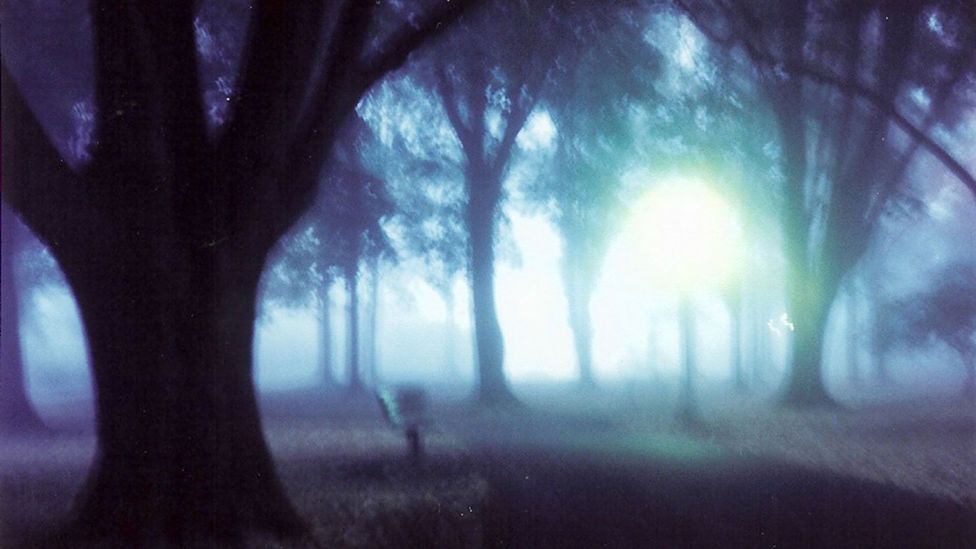
Blurred figures in images can be easily spotted if you have imagination (Credit: Doug Gelser/Picture/CC BY two.0)
Mumler was put on trial for fraud and Barnum testified against him. The most damning moment in the trial came when a deliberately bogus photograph was presented to demonstrate just how like shooting fish in a barrel information technology was to make i of Mumler'south spirit images. It was Barnum's insurrection de grace and featured himself with the 'ghost' of Abraham Lincoln. Information technology appeared Mumler was ghost-busted.
Despite the damning evidence, Mumler was acquitted of fraud, but the impairment had been done – his career as a spirit photographer was over. The techniques he used were built upon on by others during the late 1800s equally popularity for spiritualism and spirit photography grew, though accusations of fraud continued to haunt spirit photographers.
An English language priest and medium, William Stainton Moses, was i early investigator of spirit images. As Alan Murdie, chairman of the Ghost Club (founded in 1862 and believed to be the oldest paranormal investigation and research grouping in the world) explains: "By 1875 he had examined over 600 alleged spirit photographs. His view was that there were probably no more than a dozen that might pass muster as something [supernatural]… and he said that in that location are people out in that location who 'would recognise a sheet and a broom as their dear departed'."
Yet as ownership of cameras grew, spirit photography boomed. "By the 1880s anyone could selection up a camera and take a movie – it opened the door for some of the charlatans who were corking to pb people on and play on people's emotions" says Pritchard.
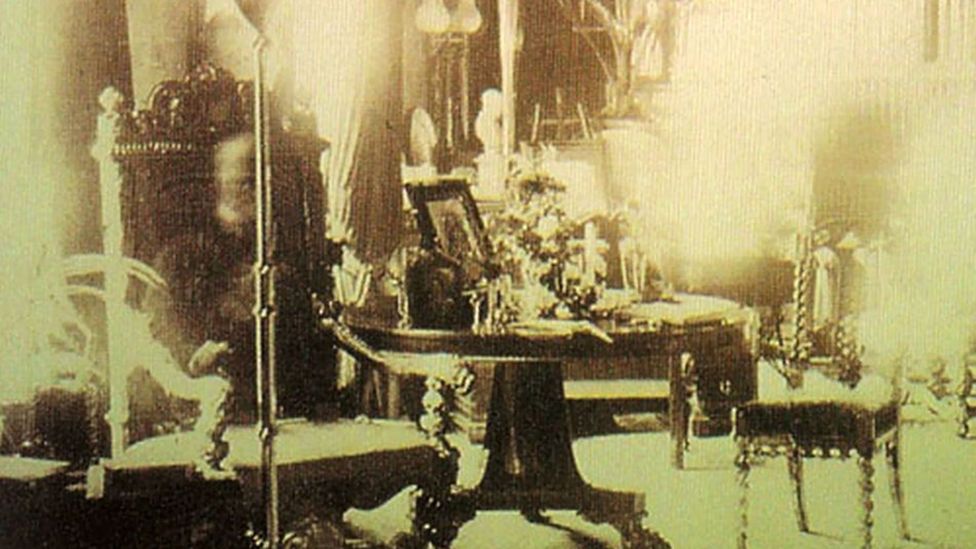
The alleged apparition of Lord Combermere is an example of a long exposure with a person entering the frame long plenty to announced in the motion picture (Credit: Sybell Corbett)
Around this period, i of the most famous spirit photographs was taken. In 1891, Sybell Corbet was taking a photograph of the library at Combermere Abbey in Cheshire, England. Sabbatum in the chair in the foreground of the shot is the faint outline of a man's head, neckband and correct arm.
It is said to be the ghost of Lord Combermere – who had recently died in a riding accident and who was existence buried at the time the picture was taken. The photographic exposure took an hr – leading many sceptics to advise that a servant had entered the room and briefly sat in the chair whilst the exposure took place. About household staff, however, claimed that they were at Combermere'southward funeral at the time.
Remembrance
By World War One, spiritualism and spirit photography had gained some notable supporters including novelist Sir Arthur Conan Doyle – a member of the Ghost Order.
The sense of loss felt in many countries after the war led some to desire a reunion with their lost relatives and friends. Englishman William Promise, past and so already an established spirit photographer, was one of those very willing to put his expertise frontward.
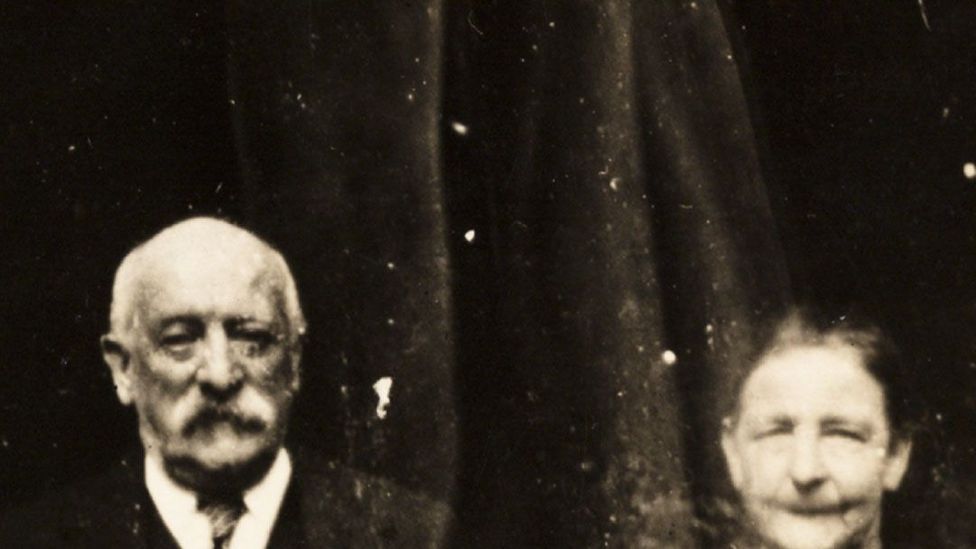
William Hope created double exposures that made it wait every bit if there were ghosts in the frame (Credit: National Media Museum)
Similar Mumler, Hope was dogged by claims of fraud, and an investigation by the Gild for Psychical Enquiry – led past famous paranormal researcher Harry Toll in 1922. Cost conducted an investigation that exposed Hope as a fraudster for double exposing two glass plates at the same time - ane featuring a ghostly image and the second to record the combination of the client and the 'ghost'. Unlike Mumler, Promise connected to practise as a medium and spirit photographer subsequently the exposure, supported past many of his ardent followers.
More than a decade later, Toll also investigated a more than inexplainable case. In 1936, two men from Country Life magazine were pictured standing at the bottom of a grand staircase in Raynham Hall, Norfolk, England. Photographer Helm Hubert Provand and his assistant Indre Shira had been near to take a snap of the principal staircase when Shira suddenly saw "a vapoury course gradually assuming the appearance of a woman" heading down the stairs towards them. Seconds later, a photo had been hastily captured. The image was published in Country Life and dubbed 'The Brown Lady'. Some believed it was the figure of Lady Dorothy Townshend, who was said to have haunted the hall since her mysterious death in 1726.
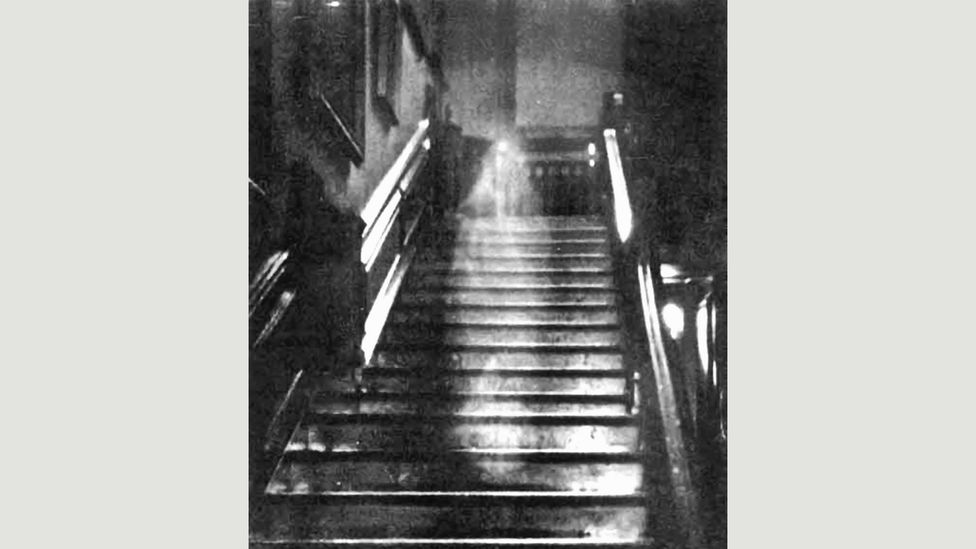
The Dark-brown Lady of Raynham Hall: The ghostly form seen here was thought to be caused by the photographic camera being shaken during a long exposure (Credit: Helm Provand)
Price was of the stance that the photographic show was untampered. "I will say at once I was impressed. I was told a perfectly unproblematic story: Mr Indre Shira saw the bogeyman descending the stairs at the precise moment when Captain Provand'due south caput was under the black cloth. A shout – and the cap was off and the flashbulb fired, with the results, which we now see. I could not milk shake their story, and I had no right to disbelieve them. Merely bunco between the two men would business relationship for the ghost if it is a fake. The negative is entirely innocent of any faking," said Price.
Others, nevertheless, were less confident. In 1937, The Gild for Psychical Enquiry, concluded that information technology was but because the photographic camera had been shaken during a six-second exposure. "I used to think at that place was maybe something in the Brown Lady of Raynham Hall until I found the original SPR research file," says Murdie.
Like many investigators, Murdie has himself seen an enormous amount of what people believe are ghosts captured on film. "I remember in that location are very few photographs that might be considered bear witness of something paranormal," he says.
Digitally departed
Today'south digital cameras are just every bit likely to create a fake haunting. The "grey lady" at Hampton Courtroom, for case, is most certainly a quirk of the technology in the girls' camera.
Unlike counterpart picture show, phones tend to have a photo in stages – in the same way a scanner moves over piece of paper. It is a slower procedure, especially in darker places where the camera telephone'south epitome sensors demand more time to record enough picture information. This is chosen 'image aliasing'. As a result, annihilation moving through the shot at the time could appear distorted.
You can also see ghost photography reborn in cyberspace memes such as 'Slender Human', a supernatural character that many people have added into photos to create a arctic.
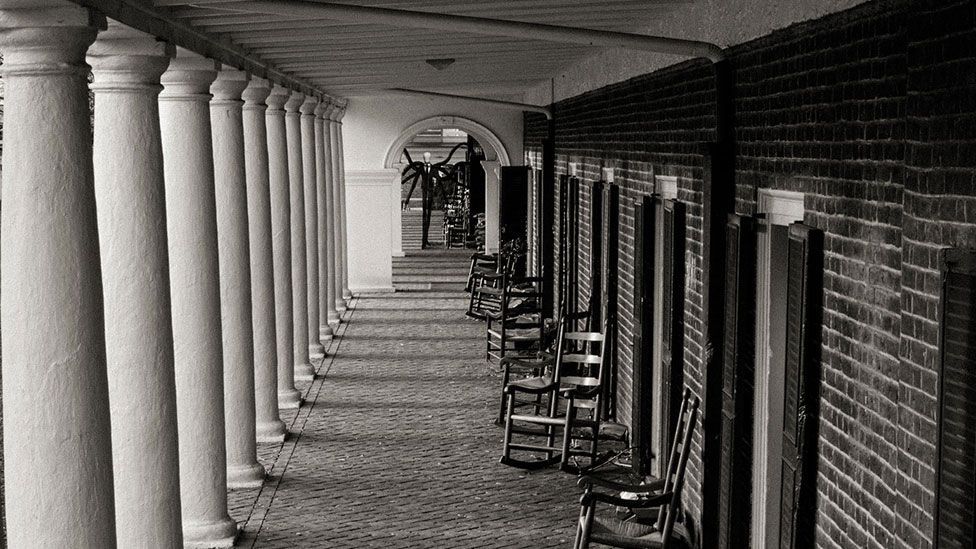
Slender Man is often barely visible in doctored photographs (Bob Mical/Flickr/CC Past ii.0)
Despite our knowledge of computer-generated trickery in photos, it seems some are still willing to believe that spirits tin can exist captured on photographic camera. Indeed, co-ordinate to a Harris poll from 2013, 42% of Americans believe in ghosts; a similar poll in 2014 by YouGov suggests 39% of United kingdom of great britain and northern ireland citizens believe a house can exist haunted.
Like the ghostly apparitions themselves, our thirst to come across life across this mortal ringlet may itself be immortal – ever shape-shifting to fit the technology and science of the time.
Follow u.s. onFacebook,Google+ orTwitter.
Source: https://www.bbc.com/future/article/20150629-the-intriguing-history-of-ghost-photography
Posted by: anthonyseellive.blogspot.com


0 Response to "What Year Was The First Camera Made"
Post a Comment